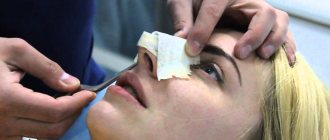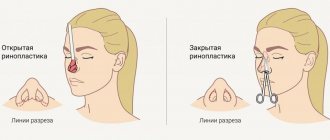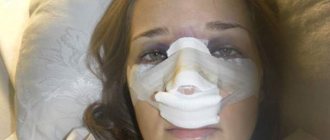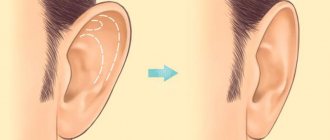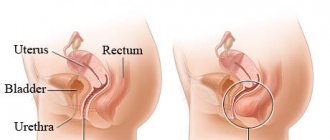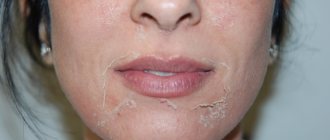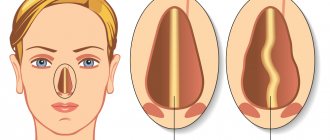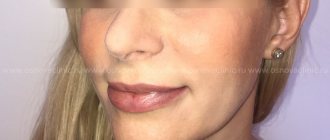Rehabilitation is important after any surgical intervention. The success of the operation depends on how the patient adheres to the doctor’s recommendations. For ear plastic surgery, recovery lasts six months. Ear bandages after otoplasty are indispensable during the rehabilitation process.
The functions of the bandage are as follows:
- reliable fixation of the auricle, maintaining the resulting shape;
- protection from traumatic effects;
- acceleration of regeneration;
- elimination of excess swelling;
- prevention of inflammatory processes.
Rehabilitation after ear surgery: early recovery period
Rehabilitation after otoplasty is a very important period in the patient’s life, since the final result of aesthetic ear correction and the speed of recovery depend on it. This is why it is so important to follow the recommendations given by your plastic surgeon after otoplasty.
The duration of the early rehabilitation period after ear surgery lasts from 7 to 10 days. After plastic surgery, the patient may experience mild pain, which can be relieved by taking analgesics. Also, after surgical correction, you may experience increased sensitivity of the ears, which will disappear on its own a few days after plastic surgery.
Rehabilitation after ear surgery is accompanied by the formation of swelling and bruising in the surgical area. These symptoms persist for 14–21 days, after which they go away on their own.
Some patients may experience an increase in body temperature in the first days after laser or traditional otoplasty. If the symptom does not go away, you should contact a plastic surgery clinic to have an aesthetic surgeon examine the wounds for signs of wound infection or tissue inflammation.
It is very important in the early rehabilitation period to wear a bandage that fixes the ears in the correct position. This can be simply an elastic bandage or a special bandage that has a universal size.
Functions of a compression bandage
In addition to the mandatory aseptic dressing, which is changed at least 3 times during the entire rehabilitation period, the plastic surgeon will insist on wearing a compression bandage. It directly affects the result of laser, reconstructive and re-otoplasty. The main functions of the bandage are:
- fixing the correct position of the ears;
- keeping the ears pressed to the head;
- protection of the aesthetic surgery site from injury and negative environmental influences;
- reduction of postoperative swelling.
The duration of wearing the bandage is determined by the plastic surgeon. On average, after surgery on the ears, you need to wear a bandage for 7-14 days. In this case, the risks of complications after otoplasty with a surgical scalpel or laser are minimized.
In the early recovery period, it is important to treat wounds and sutures after otoplasty. To do this, you should use antiseptic dressings, as well as disinfectants, for example, chlorhexidine. To heal the tissues and speed up the recovery of the ears, you should use special ointments, for example, levomekol.
Features of rehabilitation and its duration
The result of surgical intervention to change the shape of the ear depends not only on the surgical technique, but also on strict adherence to the rules of postoperative rehabilitation. Rehabilitation is a step-by-step physiological process, resulting in complete restoration of the ear tissues.
Otoplasty is performed to correct the shape of the auricle, protruding ears, and also as reconstructive operations after injuries or structural anomalies.
The operation is not considered difficult, and the rehabilitation period is short.
For successful healing, surgeons recommend avoiding physical activity, sleeping with your head elevated, not changing bandages yourself, protecting your ears from aggressive detergents, and avoiding beaches and solariums.
The stages of this type of rehabilitation include:
- Alteration – has the second name “destruction”. The period includes the destruction of cells and tissue at the site of the surgical incision.
- Exudation is the stage of formation of tissue edema, which occurs as a result of destruction in the previous period. In the resulting intercellular space, fluid is released.
- Proliferation is the beginning of cell division and tissue regeneration. First of all, connective tissue cells are replaced, which later form a scar.
- Resorption is the last stage - the severity of the connective scar decreases, and it is subsequently replaced by epithelial cells.
Earlobe plastic surgery
Earlobe plastic surgery is a popular procedure in the field of plastic surgery and cosmetology.
The presented periods follow each other in turn, promoting the restoration of damaged areas as a result of otoplasty. Rehabilitation lasts until the scar is completely reabsorbed - about six weeks.
The performed otoplasty, the rehabilitation period after which is aimed at reducing postoperative discomfort, eliminating complications, stimulating rapid tissue regeneration and increasing the aesthetic result of plastic surgery, makes it possible to correct a mistake of nature or restore the shape of the ears after injury.
Rehabilitation after ear surgery: late recovery period
If you have undergone otoplasty, how long does rehabilitation last after surgery is a question that should certainly interest you as a patient. Indeed, in the postoperative period, you should strictly follow the recommendations of the plastic surgeon who performed aesthetic correction of the auricles due to deformation of the cartilage or earlobe.
The late recovery period after complex surgery on the ears ends 30 days after plastic surgery. After surgical correction of the ears, it is important to ensure rapid tissue restoration so that complete healing of cosmetic sutures occurs.
The plastic surgeon’s recommendations in the late period of rehabilitation after reconstructive ear surgery or aesthetic correction of the earlobes include:
- Diet. To stimulate the immune system and the tissue healing process, you should eat foods rich in protein, vitamins and beneficial minerals.
- Rejection of bad habits. Smoking and drinking alcohol interfere with rapid tissue healing, which can increase the recovery period after ear surgery.
- Limiting physical activity. Sports and heavy housework should be limited to prevent tissue displacement after otoplasty.
- Avoiding sun rays. Ultraviolet radiation is very dangerous because it impairs tissue regeneration. As a result, the rehabilitation process after laser or reconstructive surgery of the auricles and earlobes can increase up to 2 months.
- Be careful when washing your hair. It is very important that after surgery, shampoos, gels and other cosmetics do not come into contact with wounds and sutures on the ears, as a chemical burn may occur.
Treatment
During the operation, manipulations are performed on the cartilaginous structures and soft tissues of the auricle. The technique depends on the existing defect. In some cases, surgery is performed using various implants. In the classic version, the operation consists of the following steps:
- Applying markings on the skin along which incisions are supposed to be made;
- Anesthesia - the operation can be performed under both general and local anesthesia;
- Incisions - most often access is made from behind the auricle;
- Cartilage modeling - depending on the existing defect, cartilage tissue is moved or removed;
- The new shaped auricle is secured with internal sutures;
- The skin is sutured with a cosmetic suture, so the scar will not be visible in the future;
- A protective bandage is applied to the intervention site and must be worn for several days.
The duration of the operation is about 40-90 minutes; the time depends on the technique and volume of the intervention, and the duration of otoplasty depends on whether one or both ears need correction.
Necessary medications
With the help of an anesthetic, the wound healing process is less painful. Minor discomfort may be felt in the first three days after surgical correction of the ears. To speed up rehabilitation after plastic surgery, the patient is prescribed:
- non-narcotic analgesics in tablet form;
- broad-spectrum antibiotics for prophylactic purposes;
- external medications in the form of ointments, creams or gels.
All medications are selected by a plastic surgeon based on the characteristics of the patient, his medical history and the presence of allergic reactions. The course of antibiotics can range from five days to one week. The prescribed products act comprehensively and promote faster restoration of the skin around the auricle, protecting it from inflammatory processes.
How can you get rid of bruises faster?
Like any surgical intervention, during laser and reconstructive otoplasty the plastic surgeon damages the skin, so bruising and postoperative swelling on the face are inevitable. The use of a compression bandage and timely drug treatment will allow you to shorten the rehabilitation period after surgery. By following the medical recommendations given by the plastic surgeon, you will be able to get rid of bruises within a week after the operation. To relieve postoperative swelling, the patient should exclude salty and spicy foods from the diet, which prevent excess moisture from leaving the body.
Tests before surgery
After consultation, if the patient is ready for surgery, a list of laboratory tests is given. If the examination results do not reveal any deviations or contraindications, the day of surgery is scheduled.
Contraindications for ear surgery:
- bleeding disorders;
- cardiovascular diseases;
- acute infectious diseases;
- pregnancy and breastfeeding;
- mental disorders;
- deviations in laboratory test results.
Otoplasty with correction of protruding ears before and 10 days after surgery
Rehabilitation after otoplasty: recommendations
After reconstructive or aesthetic plastic surgery of the ears and removal of surgical sutures, the patient should try to disturb the wound as little as possible and follow some rules before going to bed.
One of the main requirements for the recovery period after surgery may be sleeping on your back in a compression bandage. In this case, you should not wash your hair for at least a week until the plastic surgeon removes the stitches. To prevent bleeding after laser or reconstructive otoplasty of the ears, the patient should avoid physical activity that provokes an increase in pressure. You should forget about accessories in the form of glasses and earrings until the skin is completely restored. Such caution after surgery is necessary to reduce the risk of tissue infection and prevent inflammatory processes that can cause the appearance of scars and rough keloid scars in the suture area after laser otoplasty or surgery with a surgical scalpel.
The completion of the rehabilitation process completely stops a few months after the end of the operation. Sensitivity returns, the wound site stops hurting after two months. It is worth remembering that otoplasty surgery does not affect hearing in any way.
Recovery after otoplasty surgery varies from day to day for each patient individually. Photographs of patients published on our website in the “Otoplasty” section will allow you to evaluate the result of aesthetic correction of the ears.
The information on the site was personally verified by plastic surgeon Maxim Aleksandrovich Osin; if you have any additional questions, call the phone number listed on the site.

